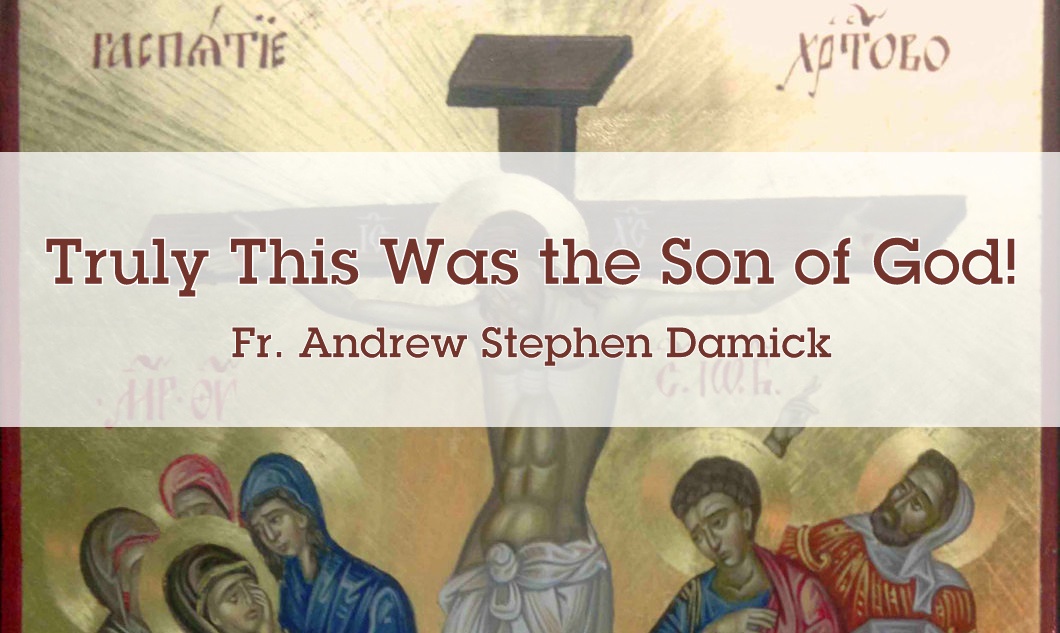
Sunday of the Fathers of the Seventh Ecumenical Council / Feast of St. Longinus, October 16, 2016
Titus 3:8-15; Luke 8:5-15
Very Rev. Fr. Andrew Stephen Damick
In the Name of the Father and of the Son and of the Holy Spirit, one God. Amen.
Our main commemoration today is the Fathers of the Seventh Ecumenical Council, who theologized beautifully on what it means for us to have icons in our churches and how we should venerate them, most especially that they are clear and precise witnesses to the incarnation of the Son of God, that God Himself became flesh and dwelt among us.
Among those who witnessed that incarnation for himself is a saint we commemorate today named Longinus. Longinus was a centurion in the service of Pontius Pilate, who delivered Jesus to be crucified. He was assigned by Pilate to bring Jesus to Golgotha for the crucifixion. It was his soldiers who nailed Jesus to the cross. It was his soldiers who placed the sign above the head of the Lord Jesus that read “This is Jesus, King of the Jews.” And it was his soldiers who cast lots for the seamless garment of Jesus.
And when the Lord of all creation died on the cross, Longinus saw for himself the signs that accompanied it—the earthquake, the darkening of the sun, the rocks splitting, and the opening up of many tombs as saints who had died rose from the dead and entered into Jerusalem.
And when Jesus bowed His head and gave up His spirit, it was Longinus who said aloud, “Truly this was the Son of God!” (Matt. 27:54, Mark 15:39).
After Jesus died, a spear was thrust into his side, and there came forth blood and water. Some traditions have associated this action with Longinus, since his name comes from the Greek word meaning spear. And the spear that committed that act is sometimes called The Spear of Destiny or The Holy Lance.
But the traditional account of the life of St. Longinus in Orthodox tradition does not say that it was he who pierced the Lord’s side nor is that action ascribed to him in the liturgical services composed in his honor. If he really had been the one who pierced the Lord’s body, it would only have made sense to mention that, but it is not. And it is hard to imagine that the one who said in reverence “Truly this was the Son of God” could bring himself to pierce that body so violently.
After Jesus’ body had been taken by Joseph of Arimathea and Nicodemus for burial, a stone was rolled in front of the tomb. The Jews, fearing that His body might be stolen by the disciples, complained to Pilate, who dispatched Longinus and his men to guard the tomb. And so he was present outside the tomb at the actual resurrection of Jesus, seeing the angel roll the stone away from the tomb and feeling the ground shaken at the moment that the Lord broke the power of death forever.
These soldiers went back to the Jews and told of all that had happened. They were then bribed to say that the disciples came and stole the body—all except Longinus, who would not take any of their money. As his Life records, he spoke boldly against the Jews, saying, “Christ indeed is true God and is risen from the dead!”
For his audacity in witnessing to the resurrection, Pilate then sought to kill him. Longinus forsook the Roman army and went with two of his companions to the Apostles, who baptized them as Christians. They departed afterward into Cappadocia, which was Longinus’s homeland. There Longinus preached the crucified and risen Jesus as though he were himself also an apostle, and many believed through him.
Some time later, as Longinus’s fame spread, Pilate eventually sent a written accusation against him to Caesar, who in turn issued a death warrant for the former centurion, which was carried out against him by beheading, along with his two companions, making him one of the earliest martyrs of the Church.
What’s striking about the life of St. Longinus is how he responded to what he saw. He saw how Jesus suffered, how He died and how He rose from the dead. And he was converted. He was changed. And even when it would have been much more convenient just to forget about what he saw and go along with the other soldiers in taking the bribe, he kept his faith. And he left everything behind and preached Christ.
Now, none of us here were eyewitnesses of the suffering and resurrection of Jesus like Longinus was. But we are indirect witnesses of a lot. We see that suffering and resurrection in our liturgical participation. And we see how history records that almost all the Apostles were martyred, going to their deaths proclaiming that they had seen Jesus alive. We see how the Holy Spirit has preserved the Church in truth and purity throughout 2000 years of troubles. We see how the Scripture attests to the truth of everything God accomplished first through the Jews and then through the Church.
But we are not only indirect witnesses. We are also eyewitnesses. We are eyewitnesses of many other things that God is doing. We have seen people in our midst who are giving up their lives in Christ’s service when they could be doing so many other things—just like Longinus did. We have seen faith growing in our midst. We have seen people giving what they have for the sake of God’s mission on this earth. We have seen people repenting of their sins. All of this is just like what Longinus did.
And we have seen the beauty of God’s salvation here in our divine services and in the precision and clarity of our Orthodox theology.
And we also have direct experience of the blessings that God gives to us. He gave us our very existence. He gave us food, shelter and clothing. He gave us our intellect, our strength and our families. He gave us this holy church. He gave us each other. And most of all, He gave us His Son, Who gave up His own life so that we might live with Him.
Now, there are people who witness all these things and receive all these things from God and yet do not respond like Longinus. They do not respond by being converted. They do not respond by putting aside what would be easiest to just keep doing and then doing what makes sense in the light of what they’ve seen instead.
But that’s not what a Christian does or is. A Christian is someone who sees all these good things and receives all these good things and then responds with conversion. And what does it mean to convert? It means changing direction, to turn around altogether. You don’t have to have some big feeling to convert. You don’t have to have what some might call a “spiritual experience” to convert. You just have to start heading in another direction.
Becoming a Christian means having a sense that things will never be the same. When you see Who Jesus Christ is and receive what He is doing, you change. You start doing something new, something aligned with what has been revealed to you.
But don’t think that, if you’ve been a Christian your whole life, this doesn’t apply to you. Don’t think that conversion is only for the new Christian. Conversion is for everyone. Why? Because we get stuck in ruts. Because we progress only so far in the faith and then stop. Because we hold on to what we learned as kids and then never mature our faith as adults. Because we have sin that needs repenting of.
Conversion doesn’t happen only at the beginning of Christian life. It’s something we keep doing. It defines what it means to be Christians. When did I convert? Constantly! I’m still converting. We’re all converts. We’re all converting. This is what Christianity is—the faith of conversion.
And we convert from our hearts, because God has touched our hearts. That does not mean that we’re looking for particular emotions. You don’t have to get all sentimental about God to be a real Christian, to convert. But you do have to make an inner decision and commitment that you’re going to follow Jesus Christ from now on, that you’re going to sacrifice, that you’re going to keep finding new ways to become more like Him.
So be like Longinus. See Who Jesus is and what He is doing. And then convert. And keep converting.
To the crucified and risen Jesus Christ be all glory, honor and worship, with His Father and the Holy Spirit, now and ever, and unto ages of ages. Amen.



